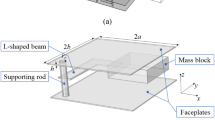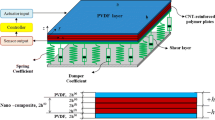Abstract
Among the infinite field of micro system of sandwich structure applications, biomedical devices are mainly vital due to their effect on society and on our health. Many technologies have been industrialized and developed to provide efficient system, including nano and micro electro mechanical systems (NEMS and MEMS) for piezoelectric applications. In this work, experimental and numerical analysis of the frequency responses of two micro electro mechanical systems are presented. The micro piezoelectric cantilever beam was used as a micro electro mechanical system. It is very useful for low frequency vibration sensors. The second system is a transducer. It is as an audio prosthesis and consists of a MEMS membrane made of an isolating interface; a AlN film acting as acoustic active material of the transducer. The finite element analysis is implemented, calculating the natural frequencies and eigenmodes of sandwich structures. We present the effect of the thickness on frequency responses for the cantilever beam. We show a good agreement between numerical results and experimental ones obtained by laser vibrometer measurements.
Access provided by Autonomous University of Puebla. Download conference paper PDF
Similar content being viewed by others
Keywords
1 Introduction
Dynamic behavior and fracture of components of mechanical structures are an important problem especially in the aeronautical and automobile fields due to dynamic loadings. Numerical and experimental studies are interested in this research field (Silberschmidt 2016, Wu et al. 2020). We are focused on looking at the dynamic behavior of micro-electro-mechanical systems (MEMS), particularly the piezoelectric sandwich structures (Heyliger and Saravanos 1995, Leung et al. 2008). Their dynamic response and mechanical behavior until damage due to vibrations and shocks has been less studied. At material level, the use of composite sandwich structures is developed in the last years, to different engineering problems. This type of structures has been widely used in aerospace and automotive applications, because of their superior mechanical properties, such as the strength-to-weight ratio. It represents an important factor in the choice of materials and dimensions in the design and manufacturing processes. Finite-element modeling is a powerful tool to predict the dynamic responses of microstructures (Wu and Lin 1990, Shu and Della 2004, Umesh and Ganguli 2008). It allows the optimization of structures before the design and realization steps. Many studies have focused numerically and experimentally on predicting mechanical characteristics of sandwich structures (Tsopanos et al. 2010, Mines et al. 2013). These structures are very complex and include imperfections over the surface of micro beams and different dimensions. These faults affect the mechanical responses of the MEMS structure.
Indeed, this study presents the finite element modeling of two sandwich structures: cantilever beam and a membrane structure. We analyze their frequency responses and their Eigen modes. The finite element (FE) model is implemented in COMSOL software. In addition, an experimental analysis of frequency responses is presented in order to define the vibration response of the both structures. With the aim to validate the numerical model, a comparison between the numerical and experimental results was developed.
2 Geometrical and Material Properties
Two structure will be studied. The firs geometry (Fig. 1) is a cantilever beam.
It is made up of two layers that composed on silicon and Cobalt-Nickel with 2.5 µm and 1µm respectively as thickness.
Table 1 represents mechanical characteristics of the cantilever beam materials:
The second geometry is the membrane piece, which is shown in Fig. 3.
This structure is a MEMS transducer adapted for in vivo implantation as audio prosthesis. The transducer is a piezoelectric sandwich structure. It contains a silicon (Si) membrane with 2 μm as thickness and 500 μm as radius, an isolating oxide interface layer with 2 μm as thickness and 400 nm as radius. It contains also two platinum (Pt) electrodes (thickness of 2 μm and radius of 150 nm), a piezoelectric layer of aluminum nitride (AlN) (thickness of 1 μm and radius of 400 μm) and a passivation layer for device protection Si3N4/SiO2 (700 nm/400 nm).
Table 2 represents mechanical characteristics of this membrane:
3 Numerical Models
The modelling and study of free vibration response of sandwich MEMS are carried out through the commercial FE code COMSOL Multiphysics 5.3. The FE model consists of two parts: cantilever beam and piezoelectric sandwich structure. The contact between the different parts is considered perfect. The free vibration analysis is carried out, obtaining the displacement and the eigenvalues. The cantilever beam structure is discretized using a fine triangle element and a swept mesh with a distribution (21786 elements). It is fixed from a part and free in the other. Furthermore, in order to validate the membrane sandwich discretization with tetrahedral elements, we implemented the FE model using a 3D element to mesh this structure (29218 elements). In this case, an extra fine tetrahedral volumetric mesh was used. As boundary conditions, the edge of the membrane Si is fixed.
The validation of experimental results (Hamamed et al. 2021), which are taken by the MSA-500 Micro System Analyzer for the membrane and the cantilever beam structures was released by numerical stimulation.
In the first step, a comparison between numerical and experimental results for the 3D and beam structures is carried out, in order to validate the both numerical models. Subsequently, we show the first three eigenmodes of the two undamaged structures. In the second step, the values of the displacement (µm) for the three first modes shape and the frequency responses in the undamaged structures will be used to analyze.
4 Comparison Between Numerical and Experimental Results
4.1 Cantilever Beam Structure
As mentioned above, a simplified model is developed in order to reduce the computational cost. We consider the 2D-node beam elements to represent the Cantilever beam structure. With the aim to validate the beam model, a comparison between the results obtained with numerical and experimental tests is developed. By considering the first three eigenmodes, the comparison is made by determine the Eigenfrequencies of vibration for the beam. Two values of the thickness of beam 250 μm and 300 μm) are studied. The different results are shown in Fig. 5.
We represent in Fig. 6, the displacement fields for the first three modes of the cantilever beam structures.
4.2 Membrane Structure
We illustrate in Fig. 7, the first three eigenmodes for the piezoelectric sandwich structure.
We noticed that the thickness of the silicon layer is the most influencing parameter. For that, the numerical results are sensible for the choice of this geometric parameter. The small difference between experimental and numerical value of the thickness of the silicon layer may modify our results.
Furthermore, after validate the 3D model, we represent in Fig. 8, the displacement fields for the first three modes of the piezoelectric sandwich structure.
5 Conclusion
In this work, we have used COMSOL Multiphysics software to design sandwich structures geometries and to validate those models experimentally. The vibration responses of the different sandwich structures was calculated by the finite element method. The different experimental tests are taken by the MSA-500 Micro System Analyzer. It measure the vibrations for different micro structures.
We showed in this paper a good agreement between the 2D and the 3D simulation and experimental results given by the laser vibrometer. This small difference between different results is explained by the fact that we do not know exactly all the properties of all layers (dimensions, homogeneity, isotropy…).
References
Silberschmidt, V.V.: Dynamic Deformation, Damage and Fracture in Composite Materials and Structures. Woodhead Publishing (2016). https://doi.org/10.1016/B978-0-08-100080-9.00001-4
Wu, X., Meng, X., Zhang, H.: An experimental investigation of the dynamic fracture behavior of 3D printed nacre-like composites. J. Mech. Behav. Biomed. Mater. (2020). https://doi.org/10.1016/j.jmbbm.2020.104068
Heyliger, P., Saravanos, D.A.: Exact free-vibration analysis of laminated plates with embedded piezoelectric layers. J. Acoust. Soc. Am. 98(3), 1547–1557 (1995). https://doi.org/10.1121/1.413420
Leung, A.Y.T., Zheng, J.J., Lim, C.W., Zhang, X., Xu, X.S., Gu, Q.: A new symplectic approach for piezoelectric cantilever composite plates. Comput. Struct. 86(19–20), 1865–1874 (2008). https://doi.org/10.1016/j.compstruc.2008.04.005
Wu, J.S., Lin, T.L.: Free vibration analysis of a uniform cantilever beam with point masses by an analytical-and-numerical-combined method. J. Sound Vib. 136(2), 201–213 (1990). https://doi.org/10.1016/0022-460x(90)90851-p
Shu, D., Della, C.N.: Free vibration analysis of composite beams with two non-overlapping delaminations. Int. J. Mech. Sci. 46(4), 509–526 (2004). https://doi.org/10.1016/j.ijmecsci.2004.05.008
Umesh, K., Ganguli, R.: Shape and vibration control of a smart composite plate with matrix cracks. Smart Mater. Struct. 18(2), 025002 (2008). https://doi.org/10.1088/0964-1726/18/2/025002
Tsopanos, S., Mines, R., McKown, S., et al.: The influence of processing parameters on the mechanical properties of selectively laser melted stainless steel microlattice structures. J. Manuf. Sci. E-T ASME 2010 132(4), 041011 (2010)
Mines, R., Tsopanos, S., Shen, Y., et al.: Drop weight impact behaviour of sandwich panels with metallic micro lattice cores. Int. J. Impact Eng. 60, 120–132 (2013)
Campanella, H., Camargo, C.J., Lopez Garcia, J., Daza, A., Urquiza, R., Esteve, J.: Thin-film piezoelectric mems transducer suitable for middle-ear audio prostheses. J. Microelectromech. Syst. 21(6), 1452–1463 (2012). https://doi.org/10.1109/jmems.2012.2211571
Hamamed, N., Hentati, H., Bouaziz, S., Haddar, M., El Guerjouma, R., Yaakoubi, N.: Numerical validation of experimental results for the dynamic behavior of sandwich structures. In: IEEE International Multi-Conference on Systems, Signals and Devices (2021, in press)
Author information
Authors and Affiliations
Editor information
Editors and Affiliations
Rights and permissions
Copyright information
© 2022 The Author(s), under exclusive license to Springer Nature Switzerland AG
About this paper
Cite this paper
Najah, H., Hamdi, H., Slim, B., Mohamed, H., Rachid, E.G., Nourdin, Y. (2022). Experimental and Numerical Analysis of Frequency Responses of Sandwich Structures. In: Hammami, A., Heyns, P.S., Schmidt, S., Chaari, F., Abbes, M.S., Haddar, M. (eds) Modelling and Simulation of Complex Systems for Sustainable Energy Efficiency. MOSCOSSEE 2021. Applied Condition Monitoring, vol 20. Springer, Cham. https://doi.org/10.1007/978-3-030-85584-0_18
Download citation
DOI: https://doi.org/10.1007/978-3-030-85584-0_18
Published:
Publisher Name: Springer, Cham
Print ISBN: 978-3-030-85583-3
Online ISBN: 978-3-030-85584-0
eBook Packages: EngineeringEngineering (R0)












